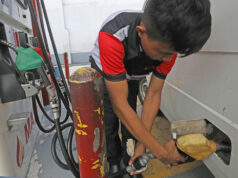Malaysia debt watcher raises Philippine rating further into investment grade
THE PHILIPPINES bagged a credit rating upgrade from a Malaysian debt watcher, which cited progress on the infrastructure front and reforms which are expected to help sustain economic growth.
RAM Rating Services Berhad raised the Philippines’ global rating to “gBBB2(pi)” — which is one notch above minimum investment grade on its scale — with a “stable” outlook.
“The upgrade is premised on sustained growth momentum, a persistent uptrend in FDI (foreign direct investment) inflows and continuous progress in reforms,” RAM said in a statement issued late Wednesday.
“The stable outlook reflects the country’s strong external position and economic resilience, balanced by the government’s narrow revenue base and elevated underemployment and poverty rates.”
This comes a year after RAM Ratings upgraded the Philippines’ rating outlook to “positive”, signalling better chances of a higher credit score.
A higher credit rating improves the chances for a country to borrow funds from foreign sources at cheaper rates, particularly from Malaysian investors in this case.
RAM Ratings also bumped up the Philippines’ rating in the former’s regional scale to “seaAA3(pi)”, citing the country’s “superior capacity to meet its financial obligations.”
In particular, the Malaysian debt watcher said the government has “made some headway” in its “Build, Build, Build” infrastructure program with 35 of 75 priority projects already approved for implementation.
“While there are execution challenges to the infrastructure push, the shift in the government’s budgeting framework from obligation-basis to cash-basis next year should help address underspending issues,” Esther Lai, RAM’s Head of Sovereign Ratings, was quoted as saying.
The Budget department last July submitted to Congress a P3.757-trillion spending plan for 2019 which requires all agencies to spend their funds within the year, plus a three-month extension for payment. A recent meeting with leaders of the House of Representatives yielded an agreement to extend payment period by three more months — or a total of six months after the end of the fiscal year — for infrastructure projects.
The reform is expected to end underspending and ensure prompt delivery of state-funded projects, coming from two-year validity of budgets in previous years under the obligation-based system.
Some House leaders had question the shift in budget system ahead of the May 2019 mid-term elections, saying they were amenable to the shift in 2020.
Recent reforms signed by President Rodrigo R. Duterte into law include the Philippine ID system and the Ease of Doing Business Act.
MOMENTUM INTACT
Malaysian credit analysts also said that the slowdown of economic growth and surging inflation are expected to be “manageable” and “transitory,” and are unlikely to affect the country’s fiscal position and investor appeal.
Philippine gross domestic product (GDP) eased to a disappointing six percent in April-June, slower than the downward-revised 6.6% during the first quarter and the year-ago 6.6%, while inflation surged to a nine-year-high 5.7% in July that pushed the seven-month pace to 4.5%, well above the 2-4% target.
Strong FDI inflows — which hit a record $10 billion in 2017 and are on track for a fresh banner year in 2018 — could help plug the growing trade deficit that has been fueled largely by heavy importation of capital equipment for business expansion, the credit rater added.
“This reflects investor optimism over the country’s growth potential as well as the continuous passage of business-enhancing reforms,” RAM Ratings said, even as it flagged that Executive-legislative differences over the second tax reform package “could hold back future investments.”
A measure that seeks to gradually cut corporate income tax rates gradually to 25% from 30% awaits plenary approval at the House of Representatives. The foregone revenues were supposed to be offset by removing tax incentives deemed redundant, but the House has stonewalled on this segment of the package, warning it could scare investors away. That left this package — initially designed by the Finance department to be revenue neutral — in a revenue-negative mode.
Watering down this package, analysts of Fitch Ratings and Moody’s Investors Service had warned two weeks ago, risks slowing the momentum of progress in state revenues and infrastructure spending.
Despite this, the debt watcher expects a 6.5% growth this year, still faster compared to the projected expansion of other Asian economies although below the government’s 7-8% goal.
Finance Secretary Carlos G. Dominguez III said the latest rating upgrade affirms the Duterte administration’s thrust to boost the “economic competitiveness” of the Philippines by pursuing fiscal reforms.
RAM Ratings’ upgrade follows similar moves from S&P Global Ratings and Fitch Ratings, which put the country on higher investment grade. — Melissa Luz T. Lopez



